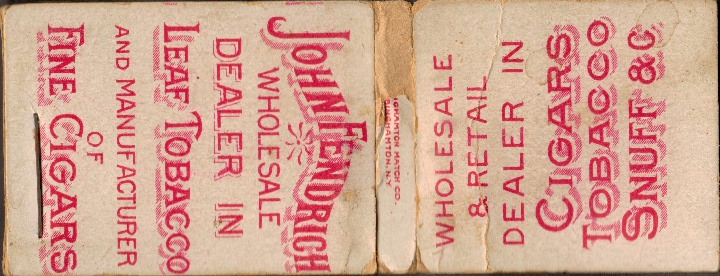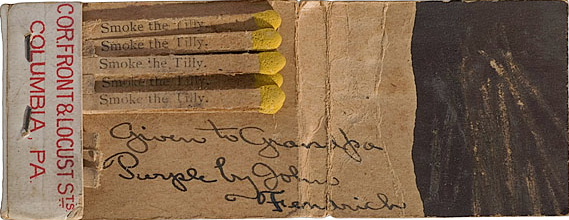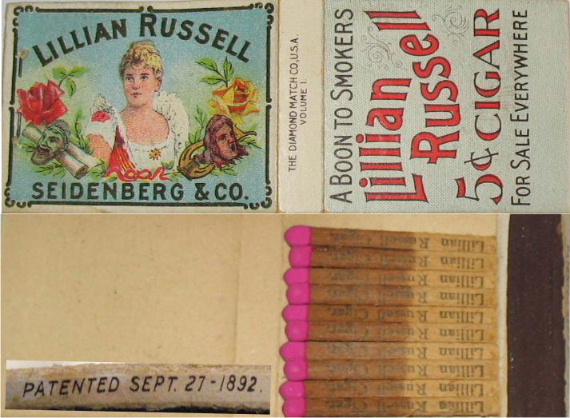|
|
Rare Matchcovers
/ Matchbooks
(more)
|
|
The
world's oldest known printed matchbook!


|
|
| |
In September 1892 attorney Joshua Pusey patented the
first friction matchbook. The Binghamton Match Co.,
established in Jan 1893, developed a matchbook based
on Pusey's design, to include a distinctive striker
located inside the cover. A very limited amount were
produced. In 1895 Pusey sold his invention to the Diamond
Match Co. who successful sued Binghamton for patent
infringement, forcing them out of business. Currently
there are only two branded Binghampton Matchbooks known
to exist, dating 1893/94.
Contrary to popular beliefs, the handmade Mendelson
Opera matchbook, said to be the oldest and made
by the Diamond Match Co., was actually made by Binghamton.
It is displayed so infrequently, current pictures showing
its real design are hardly seen. From rare modern pictures
taken by a fellow collector Jeff
Ackman, the Binghamton name on the saddle (or
top) is now mysteriously missing when compared to the
1941 Life magazine photo...see
the difference here! This has left the entire
hobby believing in the story that a group young desperate
entertainers, bought a box of blank Diamond matchbooks,
hand-printed an ad with clipped pictures and gave them
out on street corners and created the first matchbook
ad. This is now possibly proved to be innacurate.
The
thought that they copied the idea from already seen
printed Binghamton books is only a strong theory, but
it does make sense. The only two known, Fendrich Tobacco
book above and the Piso Cure book, both have printed
sticks and full cover ads. Either the Opera crew made
their own by looking at near exact examples or the Binghamton
Match Co. got a hold of an Opera book, with about 100
given away on distant street corners (or Opera House
patrons), and had a brainstorm. What we do know is that
the Mendelson book was made by covering up a Binghamton
book to include the staple, with paper and pictures.
|
|
| |
|
|
| |
The
famous Charles Lindbergh matchcover, dated June 14,
1927, is the most coveted in the hobby. It is listed in the Guinness Book of World Records as the valuable matchcover in the world, selling
for a record $6,000 in 2015. In 1952 the listed value
was $100...at the time more than a Honus Wagner baseball
card. Apparently about 200 were made to be handed out at a special dinner in which 3,200 guests attended
at the Astor Hotel in New York honoring his 1927 flight across the Atlantic. Nobody really knows why this book is so rare. One strong possibility is that it was withheld and discarded because Captain Lindbergh was promoted to Colonel the week before, rendering the matchbook completely inaccurate. In 2012 there were
eleven known to exist, almost all are hidden in private collections. Even the most advanced
hobbyists will go an entire lifetime without ever seeing
one in person. There are three in our collection, to include the current record holder.
Also shown is the Charles Lindbergh luncheon matchcover, dated the following day, June 15, 1927. This may be one of only two known. Several top collectors state they have never seen one (in person or a picture) and heard only rumors that it actually existed. Well...here it is!
Even
though digitally enhanced to remove blemishes and stains,
this is one of the few (if any) true pictures that can
be seen of either cover.
|
|
|
|
A
near impossible to find "Patented Sept. 27, 1892
(Licensed Match)" from the Diamond Match Co.
Shortly after purchasing Pusey's design in 1895, Diamond
went to work moving the striker to the outside and
began experimenting with printed ads. This particular
cover advertises the Barker Collar Co. of West Troy,
NY.
As
with many matchcovers, dating them is often difficult
unless there are some distinguishing factors or printed
dates. On May 20, 1896, West Troy officially changed
its name to Watervliet, never to be used again. This
would date this cover from 1895/86. It does not have
a striker, staple marks or folds so it was never actually
used as a matchbook. This is possibly one of, if not
the first, example of a salesman sample (flat) or matchbook
prototype made to test their new invention.

This Lillian Russell Cigar full book has the "Patented Sept. 27 - 1892" wording above the striker as well as "The Diamond Match, Co. U.S.A. Volume 1" on the saddle (top); believed to be a first generation Diamond Matchbook with less than five known. A near exact matchbook was found in 1898, located in the uniform coat pocket of James D. Brady, a Spanish-American War Army Rough Rider under Theodore Roosevelt. This book dates at or before that time.
|
|
|
|
Matchbooks
prior to the 1920's are very difficult to find. Because
these show America's support for the troops during World
War 1, they can be accurately dated from 1917-19. Without
pictures or dates, as stated above it can be very tough
to date these early matchbooks. The best way to identify
a pre-1920 is to look for the ever-so-rare Approved
Match No. 7 (Licensed Match) wording just above The
Diamond Match Book Co, N.Y. name. With these particular
covers, it is located just above the striker, although
this wording or variations have been seen located other
places, in the handful that are known. As one would imagine
a World War 1 Red Cross matchbook can be a serious
collectors dream and remarkably displayed here are four
variations...with five more in the collection. |
| |
|
|
| |
Shown
here is a near mint condition Green Hat Matches matchcover (1 of 20).
Oddly enough, it's the wording at the top, not the image
that a collector should be looking for. Dated 1926,
it is made by the Lion Match Co. for the Albert Pick
Company. Considered one the hobby's great commodities,
it is usually at, or near the top of the list of all
serious collectors. They are scarce to
find in any condition. |
|
| |
|
|
| |
A
tough matchcover, owned in both blue and red. The U.S.S. Indianapolis was commissioned
in 1932. It was torpedoed in the final few days of the
war on its return trip from delivering the first atomic
bomb to the Tinian Island before being dropped on Hiroshima.
The Japanese submarine commander in the new I-58 submarine
was eager to make a kill, knowing the war was in its
final stages. No rescue was sent and many of the survivors
drowned after their waterlogged life jackets pulled
them under. Of she ships crew of 1,197, about 900 made
it into the water, only 317 survived as sharks ate hundreds
while their helpless friends watched. It remains one
of the worst disasters in U.S. Navy history. |
|
| |
|
|
|
Launched
in 1915 the U.S.S. Arizona is most famously known for
her sinking, with the loss of 1,177 lives, during the
Japanese attack on Pearl Harbor on 7 December 1941,
the event that brought about US involvement in World
War II.
|
| |

|
|
| |
|
The
Office of War Information classified the project top
secret! They made arrangements with the Larus Bro. Tobacco
Company of Richmond Virginia to manufacture Chelsea
Cigarettes to be included in soldier's field rations.
In a wing of their factory set aside for this secret
work, Larus packaged four cigarettes in a colorful paper
label picturing the flags of the US and Philippines.
MacArthur's facsimile signature and the famous "I
Shall Return" slogan were prominently featured.
"I Shall Return" cigarettes along with matchbooks
and matchboxes, were smuggled behind enemy lines from
the U.S. Cargo Submarine Narwhal and dropped at night
from B-24 bombers. These, along with other items were
distributed by US and Filipino guerrillas and helped
keep the Filipino's hope for liberation alive until
General MacArthur returned in October 1944.
There
are two different kinds of matchbooks and one matchbox
known. Any one of them are difficult to come by and
are a prized collectible. |
|
|
|